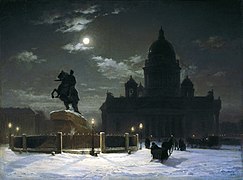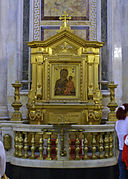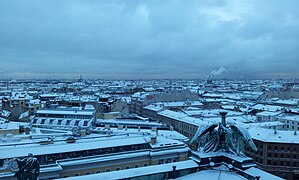Saint Isaac's Cathedral
| Saint Isaac's Cathedral Исаакиевский Cобор Isaakievskiy Sobor | |
|---|---|
Russian Orthodox | |
| Status | Museum, with church services in side chapel |
| Location | |
| Location | Saint Isaac's Square 4, Saint Petersburg, Russia |
| Architecture | |
| Architect(s) | Auguste de Montferrand |
| Style | Late Neoclassical, Byzantine and Greek (cross church) |
| Completed | 1858 |
| Specifications | |
| Capacity | 12,000[1][2] 260,000 m3 (volume)[3] |
| Length | 104.5 m (interior)[3] 111.3 m (stairs)[3] |
| Width | 91 m (interior)[3] 97.6 m (stairs)[3] |
| Interior area | 7,000 m2 (interior)[2][4] 8,000 m2 (stairs) |
| Height (max) | 101.52 m (top cross)[1][5] 31.5 m (nave interior)[3] 80 m (dome ceiling)[6] |
| Dome dia. (outer) | 25.8 m[7] |
| Website | |
| Cathedral.ru | |
Saint Isaac's Cathedral or Isaakievskiy Sobor (
History

The church on
The cathedral took 40 years to construct, under Montferrand's direction, from 1818 to 1858.
During
With the fall of communism, the museum was removed and regular worship activity has resumed in the cathedral, but only in the left-hand side chapel. The main body of the cathedral is used for services on feast days only.
On 10 January 2017 Georgy Poltavchenko, the governor of St. Petersburg, announced that the cathedral would be transferred to the Russian Orthodox Church [1]. The key protocols of the transfer were defined by the order issued by St. Petersburg's Committee on Property Relations on 30 December 2016. The document expired on 30 December 2018. The new order can be issued upon request from the Russian Orthodox Church, but no such request has yet been submitted.[2].
The transfer of Saint Isaac's Cathedral in use the ROC agreed in January 2017, but the decision has caused discontent of the townspeople, who defended the status of the museum. The decision of the city authorities was disputed in the courts.[11] Currently, the status of the building is museum.[12][13] Today, church services are held here only on ecclesiastical occasions.[14]
On 1 October 2021,
Exterior
The
The exterior is faced with gray and pink stone, and features a total of 112 red granite columns with Corinthian capitals, each hewn and erected as a single block: 48 at ground level, 24 on the rotunda of the uppermost dome, 8 on each of four side domes, and 2 framing each of four windows. The rotunda is encircled by a walkway accessible to tourists. 24 statues stand on the roof, and another 24 on top of the rotunda. The columns were made in Pyterlahti quarry in Virolahti, Finland
Dome

The cathedral's main
With an internal height of 69 m [21] (from the floor to the level of the oculus), it ranks among the tallest domes in the world.
Interior

The cathedral's
The interior was originally decorated with scores of paintings by Karl Bryullov and other great Russian masters of the day. When these paintings began to deteriorate due to the cold, damp conditions inside the cathedral, Montferrand ordered them to be painstakingly reproduced as mosaics, a technique introduced in Russia by Mikhail Lomonosov. This work was never completed.

Technologies

The meticulous and painstakingly detailed work on constructing the St. Isaac's Cathedral took 40 years to complete. This extended construction left an expression in the Finnish language, rakentaa kuin Iisakin kirkkoa ("to build like St. Isaac's Church"), for lengthy and never-ending megaprojects.
Gallery
-
The first St. Isaac's Church (Lithography of Auguste de Montferrand's drawing, 1710)
-
Vasily Surikov's view of the cathedral and the Bronze Horseman in front of it.
-
Floorplanof St. Isaac's Cathedral
-
St. Isaac blessing the Emperor Theodosius and his wife Flaccilla[8]
-
St. Isaac's southern doors, made of bronze
-
Interior of the cathedral View a 360 Panorama here
-
View of the main iconostasis, showing the malachite and lapis lazuli columns
-
Iconostasis of one of the side chapels
-
TheHoly Doors during Bright Week
-
Interior of the great dome, honoring the Holy Spirit
-
View looking out from the cathedral onto Isaac Square
-
Photo from St Isaacs Cathedral
-
St. Isaac's Cathedral at night
See also
- Cathedral of Christ the Saviour
- List of tallest Eastern Orthodox church buildings
- List of largest Eastern Orthodox church buildings
- List of tallest domes
References
Notes
- ^ a b "Исаакиевский собор". Artnight.ru.
- ^ a b "Исаакиевский собор – сердце Петербурга". Austrianyard.com.
- ^ ISBN 5-93893-160-6.
- ^ "Исаакиевский собор". Tonkosti.ru.
- ^ "Исаакиевский собор". Hotel-atlantic.ru.
- ^ "St.Isaac's Cathedral". Aviewoncities.com.
- ^ "ИСААКИЕВСКИЙ СОБОР".
- ^ a b c d e f "St. The first cathedral was built in honour of the Saint Isaac, saint patron of Peter the Great, founder of Saint Petersburg. By the end of the Paul I times on that place there was quite an ugly structure half decorated with marble blocks, half made of simple red bricks, which most of the contemporaries considered the symbol of the Paul's epoch. This was the result of Paul ordering his court architect, Brenna, to complete an earlier structure in marble by Rinaldi. Isaac's Cathedral". Nevsky Prospect. Retrieved 11 November 2011.
- ^ "Antireligious Museum" (in Russian). Saint Petersburg Encyclopaedia. Retrieved 12 November 2011.
- ^ История музея (in Russian). ГУК ГМП «Исаакиевский собор». Retrieved 12 November 2011.
- ^ "The transfer order from St. Isaac's Cathedral to the Russian Orthodox Church has expired". www.tech2.org. Retrieved 10 January 2019.
- ^ РПЦ осталась без Исаакиевского собора. www.kursk-izvestia.ru/ (in Russian). Retrieved 10 January 2019.
- ^ "ROC left without St.Isaac's Cathedral". www.latinscripts.com. Retrieved 10 January 2019.
- ^ "St. Isaac's Cathedral". www.saint-petersburg.com.
- ^ "After a century of waiting, Russians witness a royal wedding once more". NPR.org.
- ^ Ernest B. Furguson, Freedom Rising, page 54
- ^ "Wisconsin State Capitol" (PDF). National Register of Historic Places. p. 26. Retrieved 11 November 2011.
- ^ "St. Isaac's Cathedral". A view on cities. Retrieved 11 November 2011.
- ^ Gautier, Théophile; Tyson, Florence MacIntyre (1905). Russia, Volume 1. The J.C. Winston Co. p. 316.
Twelve great gilt angels, taking the part of the caryatides, support consoles on which stand the bases of the pilasters which form the interior row of the dome and separate the windows. They are twenty-one feet high, and were made by the galvanoplastic process in four pieces, whose welding together is invisible. They could in this manner be made so light that, in spite of their dimensions, they would not be too heavy for the cupola. This crown of gilt angels, poised amid a flood of light, and shining with rich reflections, produces an extremely rich effect.
- ^ The office of the first Russian oligarch (in Russian)
- ^ "Архитектура". cathedral.ru (in Russian). Retrieved 14 August 2020.
- ISBN 978-0-7277-2939-2.
- ^ "An article about the cathedral". Archived from the original on 28 August 2011.
- ^ "An article about gilding".
Sources
- Butikov, George (1974), St Isaac's Cathedral, Leningrad: Aurora Art Publishers
External links
- The Main Cathedral of the Russian Empire Official website of the State Monument Museum
- St Isaac's Cathedral
- St Isaac's Cathedral guide, a large photo collection
- St Isaac's Cathedral WebCam




![St. Isaac blessing the Emperor Theodosius and his wife Flaccilla[8]](http://upload.wikimedia.org/wikipedia/commons/thumb/4/49/Fragment_of_west_barelief_on_St.Isaac_cathedral.jpg/240px-Fragment_of_west_barelief_on_St.Isaac_cathedral.jpg)











